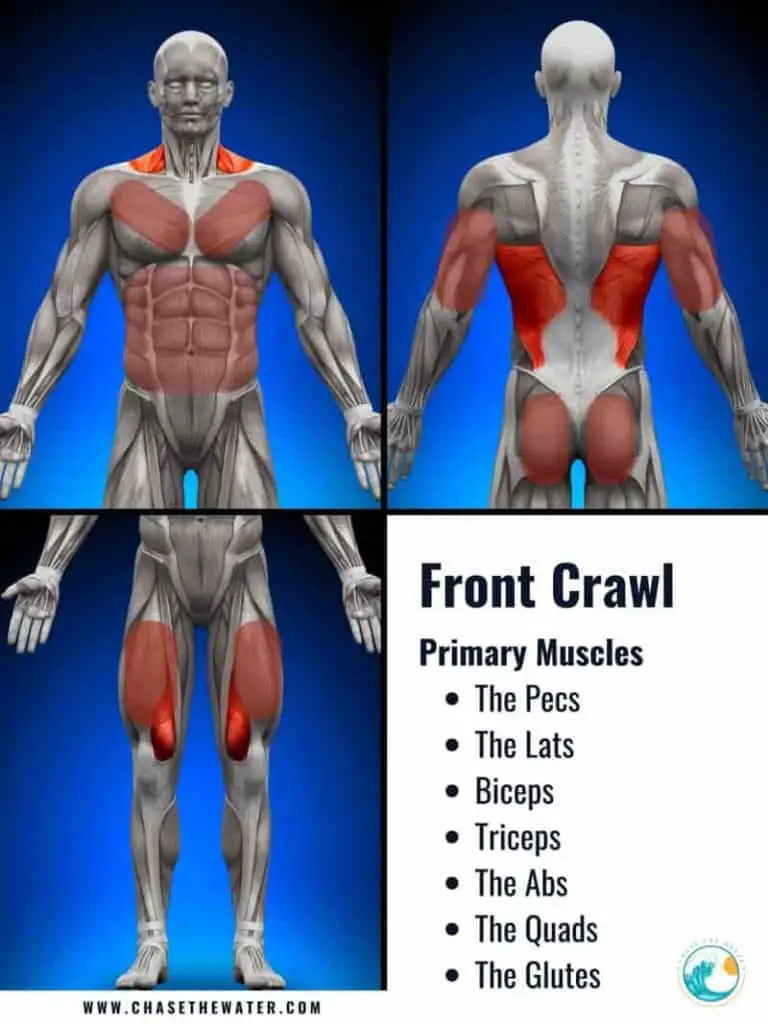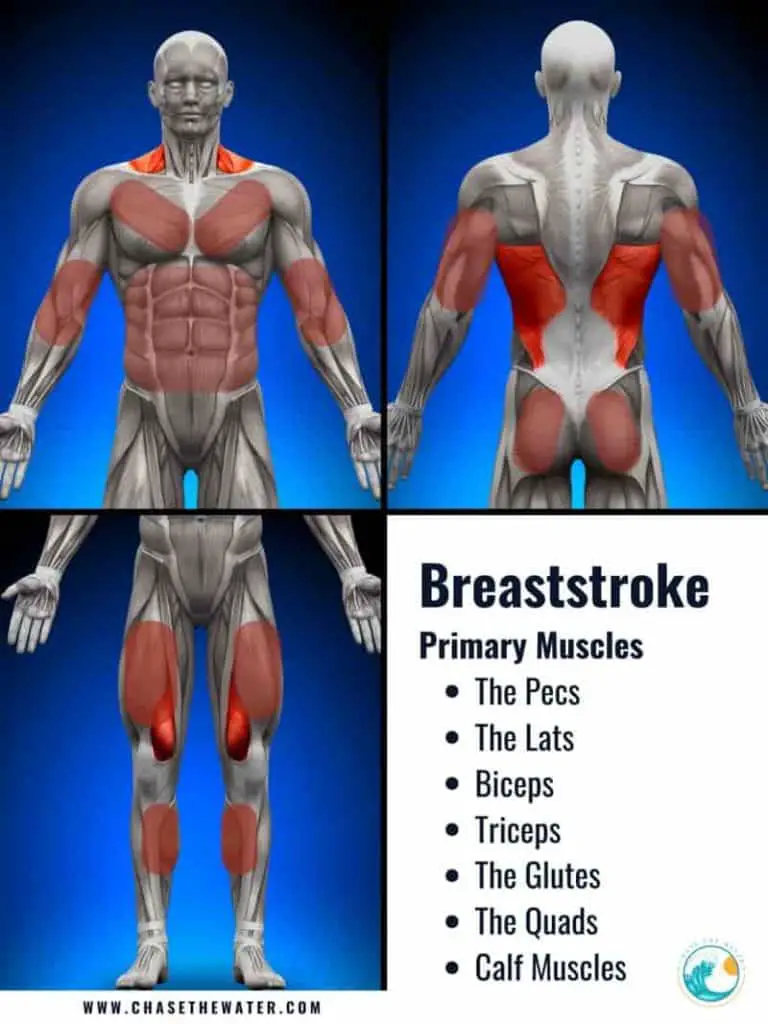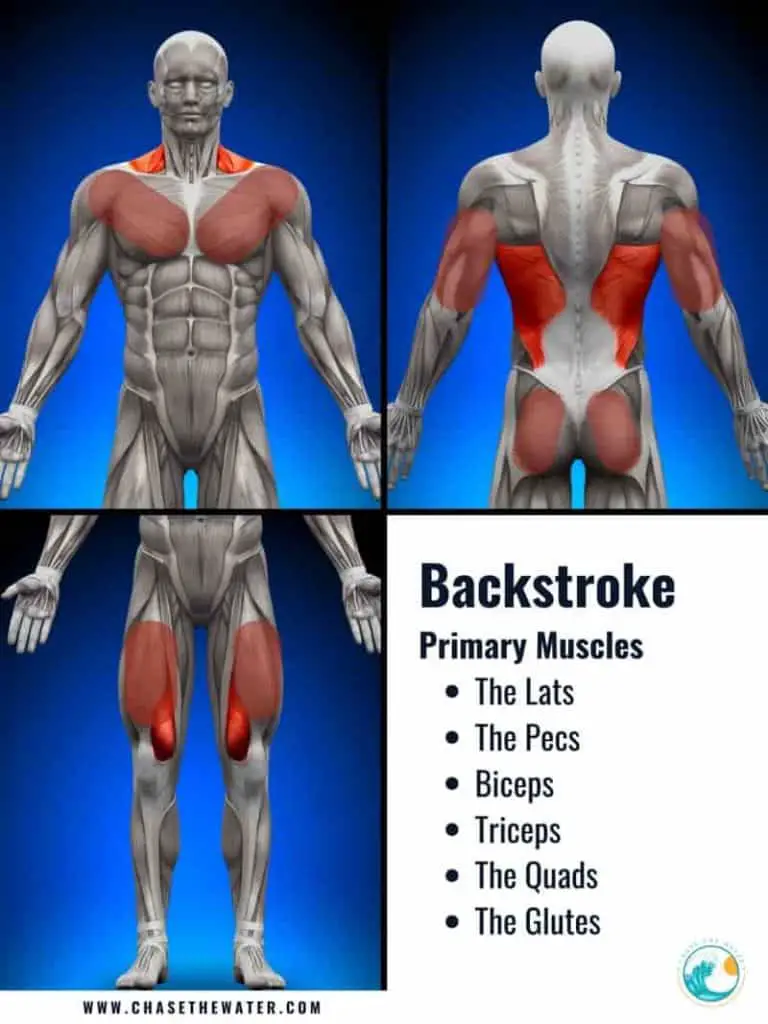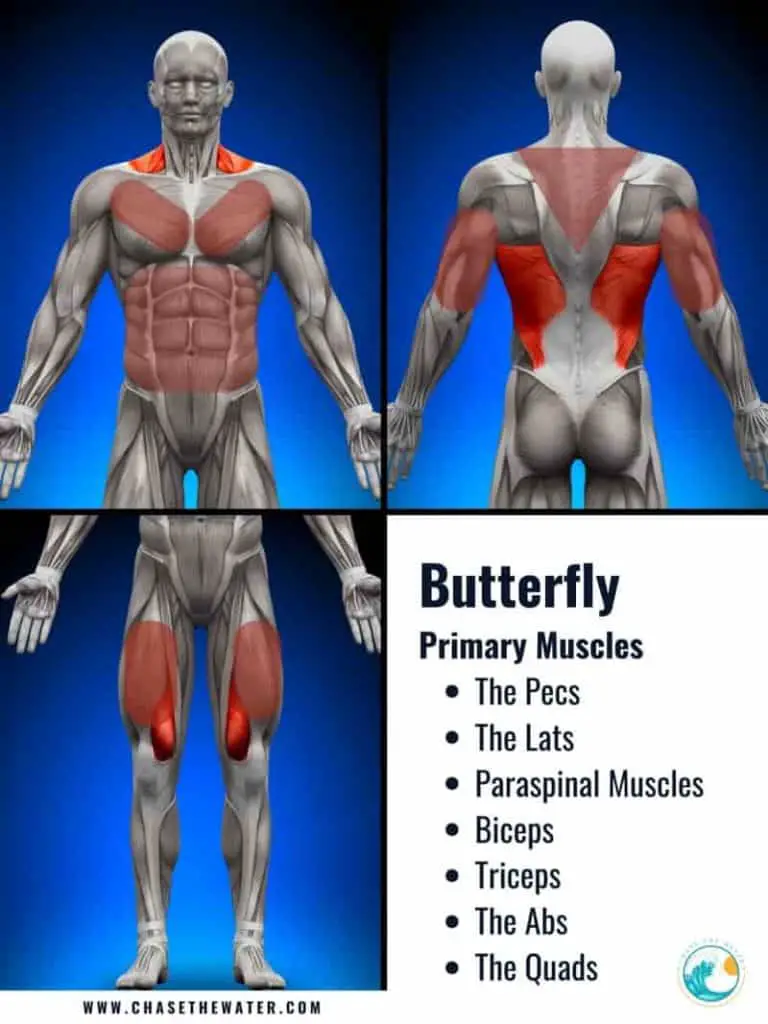We have all heard that swimming is a full-body workout, but how does this translate to our muscles?
What muscles does swimming work?
Although major muscles such as the lats (latissimus dorsi) are primarily used in swimming and known as the swimmer’s muscles, with so many stroke varieties, we can work so many muscle groups in our back, core, arms, and legs.
Swimming uses a variety of muscles across our arms, shoulders, back, chest, core, and legs. The lats, pecs, biceps, triceps, abs, glutes, and quads benefit greatly from swimming. However, the lats and pecs are used predominately across all four strokes.
In this article, we will discuss the swimming muscles worked, sharing all the primary and secondary muscle groups used with each swim stroke, detailing how they are used. I will cover:
- The Front Crawl (aka freestyle)
- The Breaststroke
- The Backstroke
- The Butterfly
Which Muscles Do I Build Swimming Front Crawl?
The front crawl, which is more popularly known as the freestyle, is one of the fastest swimming strokes and can require enormous amounts of power to swim fast.
Here is an image of the summary of some of the primary muscles used when swimming the front crawl.

In order to identify which muscles we use while swimming freestyle, let’s break the stroke down into very simple and specific movements, then identify the muscles that are involved to complete each movement.
Front Crawl Phases
- Starting Phase: The arm is extended above the head and the body is elongated.
- Propulsive Phase: The arm pulls (called the catch), and the wrist and arms flex to pull water in order to start our body moving through the water. During this phase, our back and shoulder muscles are working. This phase ends with our elbows out of the water.
- Recovery Phase: This is the movement needed to bring the arm back around to the starting phase. Several muscle groups will be in action to stabilise us in the water as arm, back and shoulder muscles move our arms back into the starting position in order to repeat the stroke.
Muscles Used In Swimming Front Crawl
We use several musical groups in our legs, core, back, and arms in order to swim the front crawl. [source]
To simplify this, I have listed the muscles we used when swimming the front crawl in the following table, identifying them by their full Latin name, their common name, and what phase of the stroke we use them in.
| Front Crawl Phase | Muscles Used (Latin Name) | Muscles Used (Common Name) | Description |
|---|---|---|---|
| Propulsive Phase (The Catch & Pull) | Pectoralis Major | The Pecs | A strong chest muscle worked as we pull through the water. |
| Propulsive Phase (The Catch & Pull) | Latissimus Dorsi | The Lats | A large back muscle which generates a lot of force while pulling. |
| Propulsive Phase (The Catch & Pull) | Biceps Brachii | Biceps | The biceps work to flex our elbow as we move from the extended to the bent arm. |
| Propulsive Phase (The Catch & Pull) | Triceps Brachii | Triceps | The triceps end the pull phase as it brings our arms out of the water and gets it ready to extend again. |
| Recovery Phase | Deltoid Cuff | – | Primary shoulder muscle group used during the recovery phase as we move our hand into position to start the next pull cycle. |
| Recovery Phase | Rotator Cuff | – | Primary shoulder muscle group used during the recovery phase as we move our hand into position to start the next pull cycle. |
| Propulsive Phase Recovery Phase | Levator Scapula | Scapula | Helps to stabilise our body as we move through the stroke. |
| Propulsive Phase Recovery Phase | Rhomboid | The Rhomboids | Helps to stabilise our body as we move through the stroke. |
| Propulsive Phase Recovery Phase | Pectoralis Minor | The Pecs | Helps to stabilise our body as we move through the stroke. |
| Propulsive Phase Recovery Phase | Trapezius (Lower & Middle) | The Traps | Helps to stabilise our body as we move through the stroke. |
| Propulsive Phase Recovery Phase | Rectus Abdominis | The Abs | Helps body roll |
| Propulsive Phase Recovery Phase | Internal & External Oblique | – | Helps body roll |
| Propulsive Phase Recovery Phase | Erector Spinae | – | Helps body roll |
| Propulsive Phase Recovery Phase | Transversus Abdominis | Core Muscles | Helps body roll |
| Downbeat Kick | The Quadriceps Music Group | The Quads | Help with the kick, engaging flexing of the knee |
| Upbeat Kick | Gluteal Muscle Group | The Glutes | Helps with kicking force |
| Kick | Hamstring Group | Hamstring | Helps with kicking force |
To feel more resistance from the water, I recommend using a pair of hand paddles. Personally I recommend the Speedo Tech Paddle (view them here on Amazon) or the TYR paddles (view them here on Amazon).

Which Muscles Do I Build Swimming Breaststroke?
Similar to the front crawl, we can break the breaststroke stroke into two key phases:
- The Propulsive Phase
- The Recovery Phase
As we start the breaststroke, we extend our arms out in front of us so we are elongated and stretched. Then we pull with our arms and shoulders.
Here is an image of the summary of some of the primary muscles used when swimming the breaststroke.

Part of the propulsive phase also involves the legs, as we kick in a frog-like pattern.
Once we are fully extended, we move from the propulsive phase to the recovery phase.
As we glide, we are fully extended, which engages our core muscles for balance and shoulder muscles.
We use many muscle groups when swimming breaststroke, which are detailed in the following table:
| Breaststroke Phase | Muscles Used (Latin Name) | Muscles Used (Common Name) | Description |
|---|---|---|---|
| Propulsive Phase Recovery Phase | Pectoralis Major | The Pecs | A strong chest muscle worked as we pull through the water. |
| Propulsive Phase | Latissimus Dorsi | The Lats | A large back muscle which generates a lot of force while pulling. |
| Propulsive Phase | Paraspinal Muscles | The Erector Spinae | This is a group of back muscles that supports your back. These muscles help lift your head out of the water to breathe. |
| Recovery Phase | Anterior Deltoid | The Lateral Deltoid | Helps to flex the shoulder |
| Propulsive Phase Recovery Phase | Biceps Brachii | Biceps | The biceps work to flex our elbow as we move from extended to bent arm. |
| Recovery Phase | Triceps Brachii | Triceps | The triceps end our arms back into position, ready to pull again. |
| Kick | Gluteal Muscle Group | The Glutes | Helps with kicking force |
| Kick | Hamstring Group | Hamstring | Helps with kicking force |
| Kick | The Quadriceps Music Group | The Quads | Help with the kick, engaging flexing of the knee |
| Kick | Adductor Muscles | – | Brings the legs together during the kick |
| Kick | Calf Muscles | – | Used to bring the ankles and feet together. |
The breaststroke can be a very explosive stroke, using a lot of power. This can result in a great body workout, especially for your back and chest muscles.
If you want to gain some extra resistance from the water, then using aqua dumbbells as part of an aqua fit routine is a great way to build muscle in the pool. Personally, I like the Speedo Aqua dumbbells, (here is a link to them on Amazon), but nearly any type will work as well.

Which Muscles Do I Build Swimming Backstroke?
The backstroke differs from the other swimming strokes in that you are swimming on your back with your face out of the water.
Unlike the front crawl, breaststroke and butterfly, where the pectoralis major (the pecs) are the first muscle group to engage as part of the stroke, with the backstroke it is the latissimus dorsi (the lats) that do the majority of pulling work.
The following image is an overview of the primary muscles used in backstroke.

We can also divide the backstroke into a propulsive and recovery phase, as we stretch our arms over our heads, catch the water, and pull to give us motion.
The arms must then rotate through the recovery phase to get back into position to repeat.
The following table details the main muscles used while swimming backstroke.
| Backstroke Phase | Muscles Used (Latin Name) | Muscles Used (Common Name) | Description |
|---|---|---|---|
| Propulsive Phase (The Catch & Pull) | Latissimus Dorsi | The Lats | A large back muscle which generates a lot of force while pulling. |
| Propulsive Phase (The Catch & Pull) | Pectoralis Major | The Pecs | A strong chest muscle worked as we pull through the water. |
| Propulsive Phase (The Catch & Pull) | Biceps Brachii | Biceps | The biceps work to flex our elbow as we move from extended to bent arm. |
| Propulsive Phase (The Catch & Pull) | Triceps Brachii | Triceps | The triceps end the pull phase as it brings our arms out of the water and ready to extend again. |
| Propulsive Phase Recovery Phase | Erector Spinae | – | Helps body roll |
| Kick | The Quadriceps Music Group | The Quads | Help with the kick, engaging flexing of the knee |
| Kick | Gluteal Muscle Group | The Glutes | Helps with kicking force |
| Kick | Hamstring Group | Hamstring | Helps with kicking force |
What Muscles Do I Use Swimming Butterfly?
The butterfly swim stroke is a very powerful and dynamic swim stroke. The stroke is executed by bringing the arms together and then sweeping them out and back in a butterfly-like motion.
Many of the same muscles used in the front crawl are also used in the butterfly; however, the arm motion also has some overlap with the breaststroke.
The following image gives an overview of the primary muscles used during the butterfly.

The butterfly has the same underwater pull stroke as the front crawl, so we use the same muscles during the propulsive phase.
Here is a list of the primary muscle groups used when swimming the butterfly.
| Butterfly Phase | Muscles Used (Latin Name) | Muscles Used (Common Name) | Description |
|---|---|---|---|
| Propulsive Phase | Pectoralis Major | The Pecs | A strong chest muscle worked as we pull through the water. |
| Propulsive Phase | Latissimus Dorsi | The Lats | A large back muscle which generates a lot of force while pulling. |
| Propulsive Phase | Biceps Brachii | Biceps | The biceps work to flex our elbow as we move from extended to bent arm. |
| Propulsive Phase | Triceps Brachii | Triceps | The triceps end the pull phase as it brings our arms out of the water and ready to extend again. |
| Propulsive Phase | Paraspinal Muscles | – | Creates the undulating movement |
| Recovery Phase | Deltoid Cuff | – | Primary shoulder muscle group used during the recovery phase as we move our hand into position to start the next pull cycle. |
| Recovery Phase | Rotator Cuff | – | Primary shoulder muscle group used during the recovery phase as we move our hand into position to start the next pull cycle. |
| Propulsive Phase Recovery Phase | Levator Scapula | Scapula | Helps to stabilise our body as we move through the stroke. |
| Propulsive Phase Recovery Phase | Rhomboid | The Rhomboids | Helps to stabilise our body as we move through the stroke. |
| Propulsive Phase Recovery Phase | Pectoralis Minor | The Pecs | Helps to stabilise our body as we move through the stroke. |
| Propulsive Phase Recovery Phase | Trapezius (Lower & Middle) | The Traps | Helps to stabilise our body as we move through the stroke. |
| Propulsive Phase Recovery Phase | Rectus Abdominis | The Abs | Helps body lift |
| Propulsive Phase Recovery Phase | Transversus Abdominis | Core Muscles | Helps body lift |
| Kick | The Quadriceps Music Group | The Quads | Help with the kick, engaging flexing of the knee |
| Kick | Gluteal Muscle Group | The Glutes | Helps with kicking force |
| Kick | Hamstring Group | Hamstring | Helps with kicking force |
We exert a vast amount of energy while swimming the butterfly. Just like the front crawl, it is a great all-body workout, exerting our arm, shoulder, back, chest, core, and leg muscles.
Final Thoughts
Swimming really is a great and full-body workout, as we can engage muscle groups from all sections of our body, including the arms, shoulders, back, chest, core, and legs.
In addition, swimming is a low-impact exercise that is easy on our joints as we are buoyant in the water.
Swimming is fantastic for toning muscles, but not for “bulking up” or growing muscle. [source]
As we are only moving our own body weight (which is lighter due to buoyance) we are never progressively loading our muscles. Our muscles will tone nicely but will not get big.
If you want to get big muscles, then it might be better to hit the gym to move a larger weight or alternatively, start using training aids such as large hand paddles (like these ones from TYR on Amazon) so you feel more resistance as you move through the water.
Before you go, if you are interested in the swimming muscles worked, you may also be interested in my article How Long Should I Warm Up For Before Swimming?
Happy swimming!

